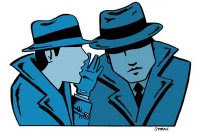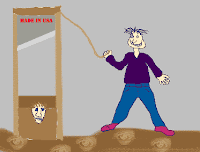

One of the most corrupt process the DOE perpetrates on the teacher is the investigation process when allegations are made against the teacher. In almost all cases the investigation is biased and unfair and assumes the teacher is guilty. The DOE investigation process is to try to substantiate teacher guilt, no matter how frivolous the charges are. Credibility is assumed for the accuser, be it a student or an Administrator, while the teacher is presumed to be not credible. It is not about the truth for these investigators it is to
"get the teacher" no matter what it takes. These investigators try their best to get teachers terminated and speaking with them just gives these investigators the tools to hang the teachers on their own words. Let's look at the corrupt DOE investigation process.
Principal's Investigation: This is the least serious and the most corrupt of the investigations if the Principal does not like the teacher. The Principal investigates incidents that
OSI and SCI dump back to them since they are not considered serious enough for the two investigative units to waste manpower on. However, the Principal is not an experienced investigator and will intimidate students or staff when doing the investigation. Furthermore, the Principal is prone to ask leading or misdirected questions that lead to erroneous statements. An example would be as follows:
Principal: "Did the teacher threaten to hit you"? Student: "No". Principal": Did you think the teacher could hit you"? Student: "Yes" Principal: So you were scared that the teacher could hit you"? Student: "I guess so". The Principal then directs the student to write a statement that he felt threatened by the teacher with physical harm. Therefore, the teacher is removed and is charged with A-420 (corporal punishment). You think that can't happen? Think again, it happens every day as principals target teachers they do not like or want in their school. You can find my take of A-420 (corporal punishment)and A-421 (verbal abuse)
here. Because the DOE lawyers know about the poor interviewing skills by the Principal, they usually try to settle with the teacher for a fine and a course or two rather than presenting the case to the 3020-a Arbitrator.
Office Of Special Investigations: (OSI) Occasionally, the allegations of corporal punishment or verbal abuse is serious enough that
OSI will do the investigation. The first question the
OSI investigator asks the Principal is:
"How do you feel about the teacher"? If the Principal does not like the teacher, the
OSI investigator will substantiate the most frivolous of incidents as serious and ask for the teacher's removal. An example of this can be found in Betsy
Combier's blog
here and
here where the
OSI investigator, Dennis Boyle, lied when he substantiated the phony corporal punishment charges on teacher Glenn
Storman. A subset of
OSI is the Office of Equal Opportunity (
OEO) and they investigate discrimination, gender bias, or sexual orientation issues. Usually the only time they give a fair investigation is when it is teacher vs. teacher.
Special Commissioner Of Investigations: (SCI) The most serious investigation is by SCI who have the ability to arrest the teacher. SCI is called in when allegations of a criminal or sexual nature is reported. The SCI investigators are semi-independent of the DOE. However, they are paid by the DOE and are listed in the DOE payroll by the City
here. While, few teachers are actually arrested, these ex-police officers can show up unannounced at the teacher's residence, school, or vehicle hoping to get the teacher to talk. More about SCI can be found
here and is required reading. The SCI investigators assume teacher guilt and will go to great lengths to substantiate teacher guilt. An example of how far SCI will go is the case of Teddy Smith where the SCI investigator substantiated the impossible. In other words he lied! You can find the shocking details
here and on
Betsy Combier's blog.The Union Position On Investigations: The
UFT position on investigations are as follows:
Meet with the Principal and a union representative (usually the Chapter Leader) about the findings of the Principal's investigation. Answer questions and follow the lead of the union representative in crafting your response.
Meet with the
OSI investigator and a union representative (usually a retired union member, sometimes the District Representative) and answer the questions simply and directly unless the union representative tells you otherwise.
Never speak to an SCI investigator without a
UFT supplied lawyer. If you are a tenured teacher, your lawyer will tell SCI not to contact you again and you will never talk to them under any circumstances.
My Position On Investigations: Give only simple yes/no answers to the Principal about the allegations leveled against you. If you choose to explain the allegation, make sure it is what you will also say in front of the 3020-a Arbitrator. Any inconsistency in statements by you can lead to termination. Remember they can lie but you can't!
As for both
OSI and SCI?
"Do not talk to them at all"! These investigators are out to get the teacher, truth and justice are irrelevant. Therefore, any defense you mount can and will be used against you by the investigators. Furthermore, the more you say the greater the chance you will give the investigators the ammunition they need to get you. Again,
"do not talk to investigators"!What the union must do to ensure fair and impartial investigations: Once a Principal calls in one of the investigative units, the union, by contract, will provide an
independent investigator who will join the investigation and be allowed to ask any witnesses the same questions the DOE investigators ask. If the independent investigator agrees with the DOE investigators that the charges are serious and true enough for the teacher to be removed. then 3020-a charges can be issued. However, if the independent investigator disagrees with the DOE investigator, the teacher cannot be removed from the classroom and no 3020-a charges can be filed. However, a mediation panel can be used to determine a lesser penalty, if any, for the teacher. Of course the mediation panel should have no ties either to the DOE or the
UFT .
In no case can a Principal be allowed to remove a teacher when the investigative units have dumped the allegations back to the Principal. The maximum punishment the Principal can do is to give the teacher a letter to the file as a result of the accusation.
Until a fair and independent investigation procedure is put in place, teachers are just target practice for the DOE firing
squad.
























